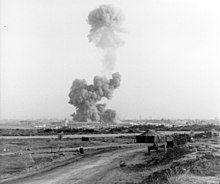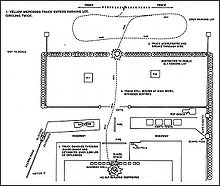Attack on the US base in Beirut in 1983
The Beirut attack on October 23, 1983 occurred during the Lebanese Civil War . The explosions of two explosive trucks, driven by suicide bombers , destroyed buildings that housed soldiers of the US Marine Corps and French paratroopers from the Multinational Forces in Lebanon (MNF). FBI experts later stated that the bomb contained at least 6,000 kilograms of explosives and thus triggered “the most powerful non-nuclear explosion on earth since World War II”. A total of 299 soldiers and 6 civilians were killed, including 241 US soldiers. A group called Islamic Jihad took responsibility for the attack, citing the expulsion of the MNF from Lebanon as its target. The attack resulted in the withdrawal of international peacekeeping forces from Lebanon. They had been stationed there since the 1982 Lebanon War .
Course of the attack
On October 23, 1983 at around 6:20 a.m., a yellow Mercedes-Benz delivery van drove to Beirut Airport , where the headquarters of the 1st Battalion of the 8th Marine Regiment of the 2nd US Marine Division was located. The van took an access road to the US Marines fenced off compound and spun in a parking lot. Then the driver accelerated and rammed the barbed wire fence that enclosed the parking lot, broke through a gate between two guards and raced into the entrance hall of the headquarters. At the time of the attack, the guards carried their weapons loaded but secured over their shoulders in accordance with the Rules of Engagement and could therefore not react quickly enough.
The suicide bomber detonated the charge with an explosive force of around 5,400 kg of TNT . The force of the explosion caused the four-story cinder block building to collapse and buried many soldiers under it. About 20 seconds later there was an identical attack on the "Drakkar" building, in which the 3rd Company of the 1st Parachute Regiment of the 11th Parachute Brigade (11ème Brigade Parachutiste) of the French Army was quartered. The second assassin drove his van over a ramp into the building's underground car park, detonated his bomb and thus razed the “Drakkar” building to the ground.
Direct impact
Rescue and clearing work dragged on for days. The rescue workers were threatened by interference from snipers. Some of the survivors were recovered from the rubble and flown to hospitals on the Akrotiri base of the Royal Air Force in Cyprus and to American and German hospitals in the Federal Republic of Germany.
241 US soldiers were killed in the attacks, including 220 US Marines , 18 sailors from the US Navy and 3 from the Army . In the second attack on the French armed forces, 58 paratroopers died and 15 survived injured. In addition, an elderly Lebanese guard of the US Marines building and the wife and four children of a Lebanese caretaker of the French building were killed. The US forces had not suffered such high casualties in one day since the first day of the Tet Offensive in 1968, with 243 deaths; for the US Marine Corps, October 23, 1983 was the blackest day since Iwojima in World War II (1945). 2,500 Marines were killed there in one day. The French army had not lost so many soldiers in a single day since the Algerian war .
Reactions
US President Ronald Reagan called the attack a "despicable act" ( despicable act ) and promised the military presence in Lebanon maintain. US Secretary of Defense Caspar Weinberger said there would be no change in US strategy for Lebanon. On October 24, 1983, French President François Mitterrand visited the French site of the attack. It was not an official visit and he only stayed a few hours. Two days later, on October 26th, US Vice President George HW Bush visited the site of the Marines' building and said that "the United States would not be cowed by terrorists." by terrorists ).
In response to the attacks, the French launched an air strike on the Bekaa plain against positions of the Iranian Revolutionary Guard . US President Reagan and his National Security Council were planning an attack on the Sheikh Abdullah barracks in Baalbek , Lebanon, which it was suspected that the Iranian Revolutionary Guard would be training Hezbollah fighters here . However, US Secretary of Defense Weinberger stopped the mission because he feared damage to relations between the United States and other Arab nations.
The US Marine Corps troops were stationed at sea where they could not be attacked. On February 7, 1984 US President Reagan ordered the withdrawal of the US Marines from Lebanon, which was completed by February 26. The rest of the multinational forces were withdrawn by April.
US President Reagan hired retired Admiral Robert Long to investigate the attack. In his report, the latter found on the one hand that there had been serious security deficiencies - access to the building had been blocked by simple barbed wire, on the other hand, the majority of US officers were of the opinion that there was a direct connection between the shelling of the Muslim side in the civil war by the American Navy and the attack existed.
evaluation
Colonel Timothy J. Geraghty, commander of the US Marines in Beirut, later said of the attack: "It should be noted that the US provided the Lebanese army with direct military aid - which I strongly criticized for a week - the village of Suq-al- Garb was shot at on September 19th. The French carried out an air strike on the Bekaa Valley on September 23. American support destroyed any belief in our neutrality and I told my staff that we have to pay with blood for this decision. " Colin Powell , who at the time for the US Defense Secretary Caspar Weinberger worked, wrote" after the US, the Shiites fired had, they had the impression that the US referee had sided. "
consequences
It is still not clear who was responsible for the attack. However, various Shiite militant groups have taken responsibility. One of them, the Free Islamic Revolutionary Movement, identified the assassins as Abu Mazen and Abu Sijaan. Another possibility of responsibility are the militant groups that later joined together to form Hezbollah , supported by Iran and Syria , as the originators of the attacks. Hezbollah, Iran and Syria deny any involvement to this day, but in 2007 Iran was sentenced to pay 2.65 billion US dollars to the bereaved in a US court.
The attack described and an earlier attack on the US Embassy in Beirut in April 1983 spawned the Inman Report , the State Department's reassessment of the security situation of US facilities around the world .
In his book The Mossad, former Katsa Victor Ostrovsky claimed that the Mossad knew about the attack plans but did not inform US intelligence services. The reason he suspected was that Israel wanted US and French troops out of Lebanon in order to operate freely.
Web links
- Information about the Lebanese civil war (English)
- Honor page for the killed soldiers (English)
- Images and information about the Lebanese civil war (English)
- John H. Kelly: Lebanon 1982–1984 - includes Diary entries by Ronald Reagan: "I have ordered the use of Naval Gunfire." - Sept. 11 1983 (English)
- Benis M. Frank: US Marines in Lebanon 1982–1984 (English)
- Lebanese Forces: Pictures after the attack on October 22, 1983 ( Memento from February 23, 2012 in the Internet Archive )
- The Beirut Memorial (English)
- Information of the National Cemetery Arlington (English)
- CNN: 20 years after the attack ( Memento of February 21, 2005 in the Internet Archive )
Individual evidence
- ↑ Wright, Robin: “The Shiites - Allah's Fanatical Warriors”, Hamburg 1985 (SPIEGEL book), p. 70
- ↑ Report of the US Department of Defense (English)
- ^ French Troops Heard Blast at Marine Headquarters, Then ... (The Associated Press, October 30, 1983)
- ^ Wright, Robin, Sacred Rage, Simon and Schuster (2001, 72)
- ↑ http://www.ina.fr/video/CAB01019515/index-video.html
- ↑ Anne Dammarell et al. v. Islamic Republic of Iran ( Memento of September 26, 2003 in the Internet Archive ) (United States District Court for the District of Columbia; PDF; English)
- ↑ http://www.lewrockwell.com/orig4/bovard1.html
- ↑ http://www.usni.org/magazines/proceedings/story.asp?STORY_ID=1616
- ↑ Powell, Colin A. and Joseph Persico, My American Journey, Ballantine, ISBN 0-345-40728-8
- ↑ 1983: Beirut blasts kill US and French troops ( BBC ; English)
- ↑ What Is Hezbollah? ( The Washington Post, July 17, 2006; English)
- ↑ flf / AFP: US court: Iran imposed billions in fine . In: Focus Online . September 8, 2007, accessed October 14, 2018 .
- ↑ Victor Ostrovsky (with Claire Hoy :) The Mossad. An ex-agent reveals actions and methods of the Israeli secret service , Bertelsmann, 1991, book no. 04880 1 ("By Way of Deception", Toronto, 1990). ISBN 3-442-15066-3 (Goldmann non-fiction book as TB: ISBN 3-426-77022-9 )
Coordinates: 33 ° 49 ′ 45 " N , 35 ° 29 ′ 41" E



